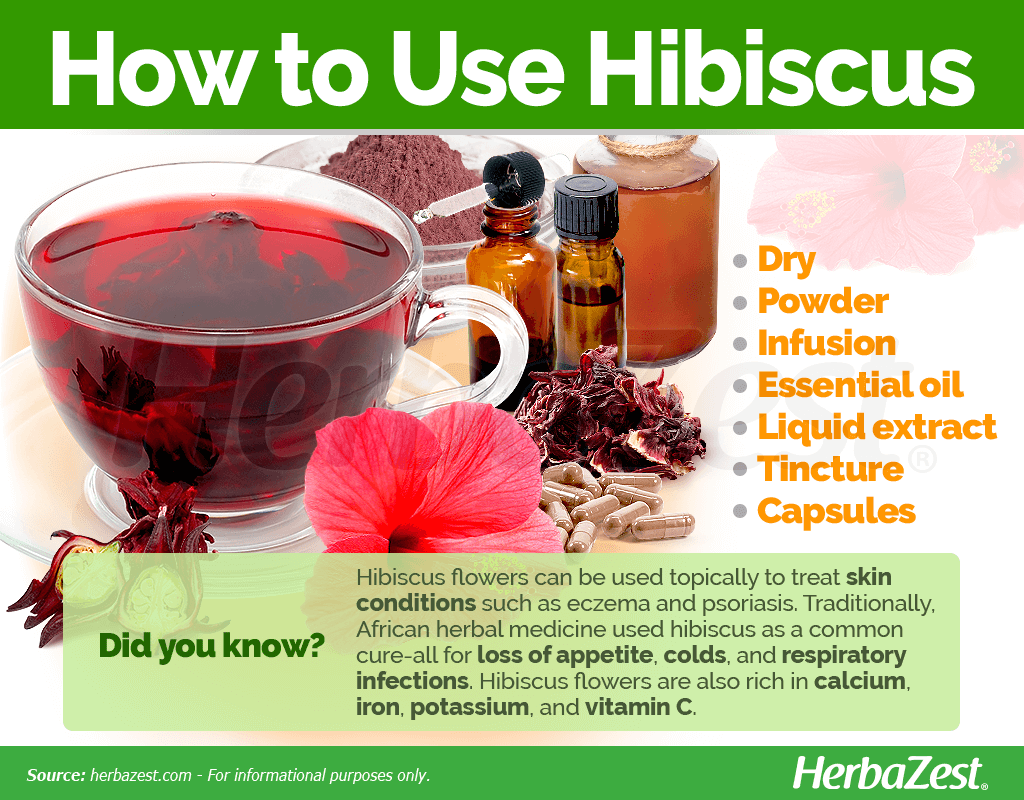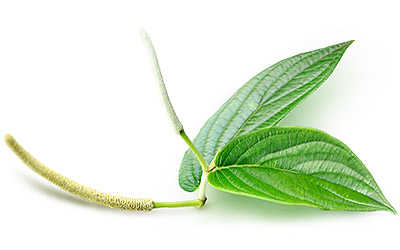Native to the sub-Saharan region of West Africa and widely known for its sweet smell and beautiful blooms, hibiscus has been an ornamental symbol of tropical lands for thousands of years. It also has been used for a variety of healing purposes.
Hibiscus Medicinal Properties
- Medicinal action Digestive, Hypotensive
- Key constituents Mucilage, organic acids
- Ways to use Capsules, Hot infusions/tisanes, Liquid extracts, Tincture, Powder, Essential oil, Dried
- Medicinal rating (3) Reasonably useful plant
- Safety ranking Use with caution
Health Benefits of Hibiscus
The medicinal properties of hibiscus have been known for millenia, and this plant has been used to treat a variety of health conditions. However, modern science has corroborated some of the following benefits of hibiscus:
Relieving gastrointestinal problems. Hibiscus has a long history of treating mild gastrointestinal discomforts, such as constipation and diarrhea.
Lowering blood pressure. Preliminary studies show that hibiscus can reduce blood pressure and other cardiovascular risk factors.
This plant is also used topically to treat skin conditions such as eczema and psoriasis. Traditionally, African herbal medicine used hibiscus as a common cure-all for loss of appetite, colds, and respiratory infections.
How It Works
Hibiscus is primarily comprised of organic acids, including citric, malic, and tartaric acids as well as vitamin C (ascorbic acid). Pectins, flavonoids, and mucilage polysaccharides are also present, bringing mild laxative, expectorant, and diuretic action. Flavonoids such as anthocyanin and beta-carotene are additionally found, as are some alkaloids and trace amounts of glucose.
Hibiscus flowers have been shown to exert spasmogenic and spasmolytic effects that can help with mild gastrointestinal issues, such as constipation and diarrhea. This is thought to be done through the activation of cholinergic receptors and the blockade of a metabolite called calcium cation, Ca(2+).1
THE MUCILAGE IN HIBISCUS COATS MUCOUS MEMBRANES TO SOOTHE THEM.
Human studies have revealed the hypotensive properties of hibiscus, which positively affect cardiometabolic risk factors by enhancing vascular function after meals.2
Due to its polyphenolic and antioxidant content, Hibiscus has shown promising results lowering LDL cholesterol and trygricerides, which can help improve lipid profile in hyperlipidemic, overweight individuals.3
Other herbs that are also helpful for aiding constipation and digestion are prune, rhubarb, and tamarind, while hypotensive properties can be found in mesquite, parsley, and saffron.
Hibiscus Side Effects & Cautions
While hibiscus is usually safe for human consumption, and rarely produce side effects, it is contraindicated in certain conditions and can interact with some medications and herbs. Those with diabetes or low blood pressure, as well as those taking medicine for these conditions, should avoid hibiscus. Additionally, pregnant and breastfeeding women should not take hibiscus. Those taking chloroquine for malaria should not take hibiscus, as the herb can make the treatment less effective. Any hibiscus use should be stopped two weeks before a scheduled surgery.

Hibiscus Nutrition
The nutritional profile of hibiscus is full of surprises. Its flowers not only contain small amounts of protein and complex carbohydrates, but are also rich essential nutrients.
Hibiscus flowers contain high levels of calcium, which is necessary for the formation of bones and teeth as well as for the proper function of body tissues, allowing optimal mobility at any age. Calcium fluctuations lead to neuronal changes and are instrumental for synapsis (the communication between neurons), this is why having adequate calcium levels positively influence the nervous system.
Good amounts of iron are also present in hibiscus flowers. This essential mineral is responsible for transporting oxygen through the body and maintaining optimal levels of hemoglobin. Keeping adequate iron levels not only prevent anemia and reduce mentrual cramps, but also boost brain function and immunity.
Moreover, good levels of potassium in hibiscus contribute to proper body's fluid balance, muscle contraction, and nerve impulses transmission as well as heart and kidney health.
Hibiscus fresh flowers contain good amounts of vitamin C (ascorbic acid), which not only has great antioxidant properties, but it is also essential for calcium and iron optimal absorption as well as for collagen production, responsable for hair, nails, and skin health. Additionally, hibiscus provides small amounts of other nutrients, such as B-Group vitamins and provitamin A carotenoids.
100 grams of hibiscus fresh flowers provide 49 calories as well a 2%DV and 4%DV of protein and complex carobohydrates, respectively.

How to Consume Hibiscus
- Edible parts Flowers
- Edible uses Flavoring, Beverage
- Taste Tart
Hibiscus is also consumed as an alternative health drink that is sweet, sour, and caffeine-free. Its flowers and calyxes are also a popular additive to desserts, jellies, syrups, and wine, and its leaves are sometimes eaten raw in salads. The calyxes are rich in vitamin A and potassium.
However, the remedial forms of the herb concentrate its properties for medicinal uses.
Natural Forms
Dried. Hibiscus flowers are generally sun dried before using them. They need to be boiled, or stepped in hot water in order to extract the medicinal properties of hibiscus.
Powder. Once dried, hibiscus flower can be pulverized for commercial and medicinal purposes, and can be added to smoothies and infusions.
Infusion. Brewing its dried upper parts is the most common way to consume hibiscus. Typically, 1.5 grams are used per cup of water.
Herbal Remedies & Supplements
Essential oil. Due to its antibacterial properties, hibiscus essential oil can be of help for the treatment of skin problems, such as eczema and psoriasis. Other benefits of hibiscus in this form are relieving inflammation, anxiety, and insomnia.
Liquid extract. Free of alcohol, hibiscus liquid extract deliver all the benefits of the plant. However, this concentrated preparation needs to be added in small amounts to a glass of water, or tea.
Tincture. This concentrated for of hibiscus, which uses alcohol as a medium, needs to be diluted in water before consumption, is typically used for antibacterial purposes.
Capsules. In this supplemental form, hibiscus can be taken in estandardized doses ir order to benefit digestive health, hypertension, and other health conditions.

Growing
- Life cycle Perennial
- Harvested parts Flowers
- Light requirements Full sun
- Soil Loamy sand, Well-drained
- Growing habitat Warm climates
- Propagation techniques Cuttings
- Potential insect pests Aphids, Mites
The hibiscus bush is a perennial and resilient species grown in tropical and subtropical regions of the world. With proper care and due the right conditions of climate and soil, it can be cultivated in landscapes and gardens.
Growing Guidelines
The hibiscus plant responds best to constant sun and relatively high temperatures, ranging from 55 - 81°F (12.5 - 27.5°C). However, flowers will not bloom if daily exposure is less than 11 hours or more than 13 hours at a time.
A humid climate and acidic, rich soil, with a good drainage are ideal for an hibiscus bush to thrive. The soil must be humid but not saturated, and never should be dry.
Cuttings are the easiest method to propagate hibiscus plants. Seedlings must be kept out of direct sunlight for 3 to 5 weeks, while they develop strong roots. After that period they will be ready to be repoted of transplanted.
Hibiscus plants need a lor of nutrients. A balanced fertilizer every 2-3 weeks is ideal for optimal growth.
If growing them outdoors, hibiscus bushes should be placed in a sunny spot, protected from strong winds and frost.
Hibiscus can be grown as an annual plant further north, flowering in late autumn months. Its beautiful flowers are short-lived, and usually survive only one day after blooming.
It is advisable to prune the hibiscus bush in late winter, in order to stimulate further growth.
- Hibiscus species are prone to yellowing, usually caused by changes in temperature and soil humidity. The most common pests that attack hibiscus are aphids and mites.
More detailed information about growing hibiscus can be found in the herb garden section.
Additional Information
- Other uses Textiles, Fiber, Dye
Plant Biology
Standing up to 13 feet (4 m) tall, hibiscus features an erect stem with lobed leaves and single, double or triple flowers, which can be red, yellow, white, peach, or show mixed colors. The petals are contained in a bright red, fleshy pod known as a calyx. Calyces are the most widely used part of the plant for their concentration of nutrients and sweet-sour flavor.
Classification
A member of Malvaceae family, hibiscus (Hibiscus sabdariffa) is connected to nearly 2,300 species of flowering plants, most including cacao, cola nut, hollyhock, mallow, and marsh mallow.
Varieties and Subspecies of Hibiscus
There are two distinct varieties of hibiscus: Hibiscus sabdariffa var. sabdariffa, which is more commonly used for food and drink purposes; and H. sabdariffa var. altissima, which is inedible but particularly useful for creating fiber. Other members of the Hibiscus genus are not to be confused with H. sabdariffa, although they share a common name. The majority have no medicinal value, despite their other pleasing aspects.
Historical Information
In sub-Saharan West Africa, hibiscus has been used since time immemorial as a medicinal cure-all for mild and serious conditions alike. From there, the plant spread east across the continent and up through the Middle East, whence it was transported to Asia and became renowned for its myriad of uses. When the European slave trade started to pick up steam in the 15th and 16th centuries, residents who were captured and brought to the Americas carried the flower in their parcels and later spread it throughout the Caribbean, where it was employed chiefly as a fiber.
Popular Beliefs
Folk traditions claim that hibiscus can be a hangover cure and aphrodisiac, although little scientific evidence exists to support such uses.
Economic Data
Crop cultivation of hibiscus is a major industry in several tropical countries and further contributes to the national wealth. Thailand, India, and Bangladesh are the leading producers today, representing roughly 90% of the jute production industry. In Sudan, however, the flower is also listed among the top ten foremost crops annually grown, with dried flowers generating just over $14 million USD in 2012 alone. Caribbean nations, such as Cuba and the U.S. Virgin Islands, also benefit from its export.
Other Uses
Gardening. because of its aesthetic beauty, hibiscus is often used as an ornamental in gardens and parks.
Crafts. The plant is chiefly applied to making jute, a fiber common in developing countries as rope that is sometimes then used to make clothing, bags, carpet backing, and floor coverings.
Dye. From the hibiscus flowers, of different colors, natural pigments can be obtained..
Sources
- Cell Calcium, Calcium signaling and synaptic modulation: Regulation of endocannabinoid-mediated synaptic modulation by calcium, 2005
- Fitoterapia, Hibiscus sabdariffa L. in the treatment of hypertension and hyperlipidemia: a comprehensive review of animal and human studies, 2013
- Journal of Research in Medical Sciences, Oxidative stress and hypertension: Possibility of hypertension therapy with antioxidants, 2014
- Lost Crops of Africa, Hibiscus sabdariffa
- Technical Centre for Agricultural and Rural Cooperation (CTA), A Study for the Development of a Handbook of Selected Caribbean Herbs for Industry, 2002
- University of Minessota, Extension|Hibiscus
- Botany: An Introduction To Plant Biology
- FAOSTAT, Jute, Kenaf and Allied Fibres
- MedlinePlus Herbs and Supplements, Hibiscus
- USDA Nutrient Database, Roselle, raw
- Journal of Medicinal Food, Determination of Antimicrobial Activity of Sorrel (Hibiscus sabdariffa) on Esherichia coli O157:H7 Isolated from Food, Veterinary, and Clinical Samples, 2011
- Medicinal Plants of the World
- Wudpecker Journal of Agricultural Research, Variability in Some Roselle (Hibiscus sabdariffa L.) Genotypes for Yield and its Attributes, 2013
Footnotes:
- Journal of Ethnopharmacology. (2005). Presence of cholinergic and calcium channel blocking activities explains the traditional use of Hibiscus rosasinensis in constipation and diarrhoea. Retrieved July 2, 2023, from: https://pubmed.ncbi.nlm.nih.gov/16182481/
- Nutrients. (2019). Acute Effects of Hibiscus sabdariffa Calyces on Postprandial Blood Pressure, Vascular Function, Blood Lipids, Biomarkers of Insulin Resistance and Inflammation in Humans. Retrieved July 2, 2023, from: https://www.mdpi.com/2072-6643/11/2/341
- Materia Sociomedica. (2013). Effect of Hibiscus sabdariffa Calices on Dyslipidemia in Obese Adolescents: A Triple-masked Randomized Controlled Trial. Retrieved July 2, 2023, from: https://www.ncbi.nlm.nih.gov/pmc/articles/PMC3769081/









